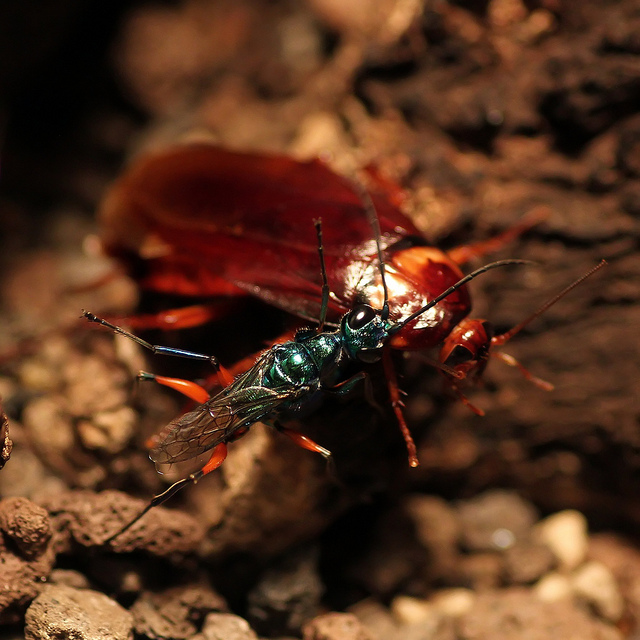Reproduction
The parasitoid emerald cockroach wasp has an incredibly interesting life cycle that requires the American cockroach (Periplaneta Americana) and only the American cockroach. The female Emerald Cockroach Wasp (Ampulex compressa) uses her complex venom to immobilize the cockroach before laying a single egg on the cockroach’s abdomen. The immobilization of the host takes place through two separate venomous stings: the first into the central nervous system to paralyze the front legs and the second directly into the cockroach’s ganglia. Both stings are done with near surgical accuracy. If the wasp is even the slightest bit off her target, the entire process could end up in failure. Additionally, if too much venom is used, the cockroach could die or, if too little is used, the cockroach could recover from the venom and escape before the wasp’s eggs can be laid or hatched (Fox, et al. 2009).
Once the cockroach is in deep in hypokinesia (a state where the
cockroach has all motor functions intact, but has lost all ambition
for escape), the wasp will chew off the ends of the cockroach’s
antennae and sucks a small amount of the cockroach’s hemolymph to
replace the energy lost from her attack. Once she regains her vigor,
she is able to lead the cockroach six times her size into her burrow
by its own antennae as if it were a leash. Once the subdued cockroach is
safely inside the burrow, she proceeds to lay a single egg on its
abdomen. Finally she fills the burrow entrance with debris to keep the
cockroach in as well as predators out. The cockroach will remain in hypokinesia for anywhere from 1-4 weeks after a direct sting to the
ganglia from the emerald cockroach wasp (Banks et al. 2012). During this time, the egg
hatches into its larvae form and burrows into the live cockroach's
body to become an endoparasitoid. Once inside, it procedes to
consume the
cockroach’s organs and hemolymph for nourishment. Endoparasitoids are generally
classified by their likeliness to kill the host that feeds them,
making them slightly less effective in relation to other parasites.
Inside the cockroach, the larva undergoes metamorphosis to evolve
into its pupa form in
which it is able to constructs a cocoon to allow itself. Once in the
cocoon, the pupa fully
matures into its adult wasp form. This observed metamorphosis is a characteristic
of all insects including
Cimbex americana and
Hyphantria cunea. This entire development process
from egg to the point where the adult emerald cockroach wasp emerges from the dead
cockroach’s body is approximately six weeks.
cockroach wasp (Banks et al. 2012). During this time, the egg
hatches into its larvae form and burrows into the live cockroach's
body to become an endoparasitoid. Once inside, it procedes to
consume the
cockroach’s organs and hemolymph for nourishment. Endoparasitoids are generally
classified by their likeliness to kill the host that feeds them,
making them slightly less effective in relation to other parasites.
Inside the cockroach, the larva undergoes metamorphosis to evolve
into its pupa form in
which it is able to constructs a cocoon to allow itself. Once in the
cocoon, the pupa fully
matures into its adult wasp form. This observed metamorphosis is a characteristic
of all insects including
Cimbex americana and
Hyphantria cunea. This entire development process
from egg to the point where the adult emerald cockroach wasp emerges from the dead
cockroach’s body is approximately six weeks.
However, before the female is even capable of laying an egg on an incapacitated cockroach’s body, she has to mate with a male. Males produce gametes in the form of sperm through meiosis which fertilize the female’s gametes (eggs) to form a zygote. The zygote egg is then laid on the cockroach host where it hatches and the cycle continues after the adult develops.
Click here for a short video showing how Ampulex compressa uses the American cockroach for its reproduction.
